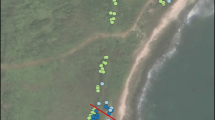Summary.
Ants have the capacity to reach unusually high densities, mostly in their introduced ranges. Numerical dominance is often cited as key to the ability of exotic ants to displace native ant species, reduce the abundance of invertebrates and negatively impact upon bird, land crab and other vertebrate populations. On Christmas Island, Indian Ocean, the yellow crazy ant, Anoplolepis gracilipes (Jerdon), forms supercolonies, where extremely high densities of foraging ants have contributed to ‘invasional meltdown’ in rainforest areas. Densities of up to 2254 foraging ants per m2 and a biomass of 1.85 g per m2 were recorded, and nest densities reached 10.5 nest entrances per m2. Populations of A. gracilipes can overcome and kill red endemic land crabs (Gecarcoidea natalis) over 100 times their own biomass. This is the highest recorded density of foraging ants, and adds another element to the definition of ‘supercolony’ of unicolonial ants. This paper documents one extreme in a continuum of densities of unicolonial, invasive ant species and highlights the need to incorporate forager densities into invasive ant research.
Similar content being viewed by others
Author information
Authors and Affiliations
Corresponding author
Additional information
Received 17 November 2004; revised 14 February 2005, accepted 21 February 2005.
Rights and permissions
About this article
Cite this article
Abbott, K.L. Supercolonies of the invasive yellow crazy ant, Anoplolepis gracilipes, on an oceanic island: Forager activity patterns, density and biomass. Insectes Soc. 52, 266–273 (2005). https://doi.org/10.1007/s00040-005-0800-6
Issue Date:
DOI: https://doi.org/10.1007/s00040-005-0800-6




